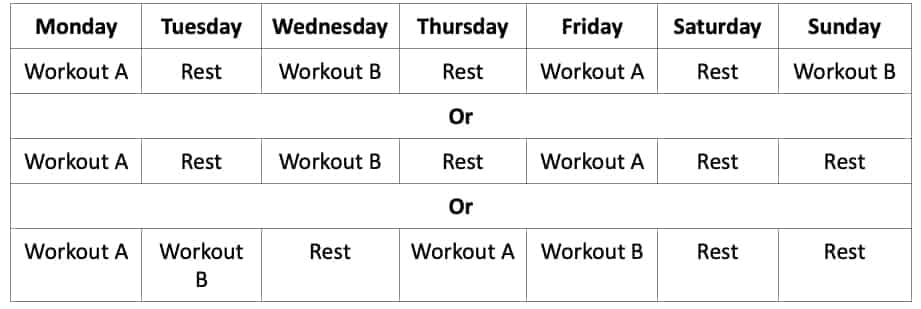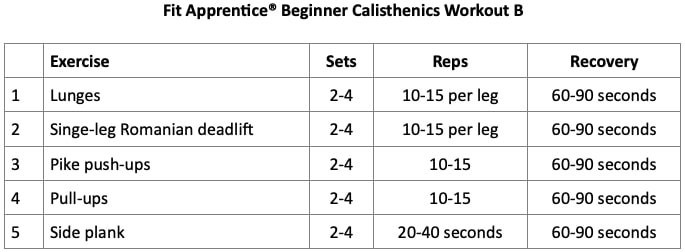Beginner Calisthenics Workout Plan – Introduction
Calisthenics Workout for Beginners at Home: The Ultimate Routine
It’s a fact: exercise is good for everybody’s body!
According to the Centers for Disease Control (CDC), adults should do 150 minutes of moderate or 75 minutes of intense exercise per week – MINIMUM.
This volume of exercise will help you get fit and improve your health.
Combined with a sensible diet, it should also help you lose or control your weight.
But what type of exercise should you do?
After all, there are LOTS to choose from.
For example, you can walk, ruck, swim, cycle, run, row, jump rope, or even yoga your way to fitness and health.
That said, one of the best workouts for health and longevity is strength training.
Strength training builds muscle strength and bone density and offsets many of the ravages of aging.
You can also use strength training to sculpt your muscles and improve your body shape.
And yes, strength training burns fat, too.
But before you run off to the gym and start pumping iron, it’s important to understand that you don’t have to use barbells, dumbbells, and machines for strength training.
There is another type of training that’s just as effective and often much more convenient: calisthenics.
In this article, we reveal what calisthenics is, discuss its advantages and benefits, and provide you with a great beginner workout to try.
What Is Calisthenics?
Calisthenics is a type of workout where you use your own body weight for resistance.
It’s also sometimes called bodyweight training.
The word calisthenics originates from the Greek words for beauty and strength.
This should give you an idea of a) how old calisthenic training is and b) how it will affect your body.
Broadly speaking, there are two types of calisthenics – progressive and skill-based.
Progressive calisthenics involves doing gradually more demanding bodyweight exercises to increase your fitness and strength.
For example, you might progress from push-ups on your knees to push-ups on your toes to handstand push-ups.
Skill-based calisthenics focuses more on performing gymnastic moves like muscle ups, planches, and the human flag.
This type of calisthenics is more advanced and great for building maximal strength but can be hard on your joints, and some moves can take months, if not years, to learn.
So, for this article, our focus is on progressive calisthenics movements, as that’s the most accessible for a complete beginner.
Calisthenic Benefits
Is calisthenics the right workout for you?
Consider these benefits and then decide!
Work out anywhere and anytime
Using your body weight for resistance, you don’t need to go to a gym to do calisthenics.
In fact, you can work out at home, at a park, in your hotel room, or anywhere else you’ve got a little bit of space.
Not having to travel to work out removes two of the biggest barriers to exercise adherence – lack of facilities and lack of time.
It’s free!
Fed up with the rising costs of gym memberships?
Ditch the gym and do calisthenics instead.
There are lots of exercises you can do without equipment, so you can work out for free.
Easy to progress/regress
While there ARE advanced calisthenic exercises, many can be adapted for beginners.
Similarly, those same exercises can often be made more challenging.
In short, you can adjust most calisthenic workouts to suit your current fitness and strength and progress them as you get stronger.
Joint-friendly
With no heavy weights involved, calisthenic exercises are often more joint-friendly than their weight-training equivalent.
Take the bodyweight squat as an example; with no bar resting uncomfortably on your back, you can focus on perfecting your form and pumping out rep after perfect rep.
Also, no weight means much less stress on your fragile lumbar spine.
Heavy weight training can leave you feeling beaten up and in need of a day off after your last workout.
In contrast, calisthenics is less taxing, and you should be able to work out more often, leading to better results in less time.
Calisthenic Drawbacks
Of course, no exercise system is perfect, and that includes calisthenics.
Potential drawbacks of calisthenics include:
Movement and muscle imbalances
Basic bodyweight calisthenics tends to focus on upper and lower-body pushing exercises like push-ups and squats.
To develop a balanced physique, you also need pulling exercises in your workout schedule.
Invariably, pulling exercises require equipment, most notably a pull-up bar, gymnastic rings, or a suspension trainer.
While this is a modest investment compared to buying weights, benches, and a squat rack, it may still be more than some people want to spend.
High-rep training is the norm
A lot of calisthenic workouts involve doing high reps.
That’s because the resistance is fixed, and the only way to fatigue your muscles is by doing the exercises for a long time.
For example, you could find yourself doing 50-100 bodyweight squats.
Some people will find this type of training boring.
However, there ARE ways to make almost all calisthenic exercises harder so you don’t have to do such high reps.
For example, you can:
- Increase your range of motion – squat deeper or do push-ups with your hands on raised bars called parallettes.
- Narrow your base of support – bring your hands or feet closer together.
- Change the angle of your body to put more weight on your supporting limbs – raise your feet during push ups.
- Slow your tempo – slower movements are much more demanding.
- Do explosive reps – jump squats are far more challenging than regular squats.
- Add mid-rep pauses – pause for 3-5 seconds with your chest an inch from the floor during push-ups or at the bottom of squats and lunges.
- Do your exercises on one limb – single-arm push-ups and single-leg squats.
- Switch to a more challenging exercise – progress from rows to pull-ups.
Some exercises require a good level of strength to perform
Using your body’s weight for resistance is a double-edged sword.
On the one hand, it means you are your own gym and can work out almost anywhere and anytime.
On the other hand, it also means that you must be strong enough to lift your own weight.
This can be a problem for beginners, older exercisers, and heavier people.
As such, some calisthenic exercises may be beyond your abilities.
However, using regressions should mean you can still get an effective workout with calisthenics, even if you do have to modify some of the exercises.
Best Calisthenics Workout for Beginners at Home
Calisthenics is a great way to work out, but don’t take our word for it; try this home calisthenics routine and experience the power of calisthenics for yourself!
This routine consists of two programs – A and B.
Simply alternate them whenever you work out.
For example:
Home Calisthenics Workout Schedule Options

But, before you do either workout, spend a few minutes warming up and preparing your body for what you’re about to do.
Begin with 5-10 minutes of easy cardio, e.g., jogging or jumping rope, followed by dynamic stretches and mobility exercises for your main muscles and joints.
Warmed up and ready to go?
Then let’s get to it!
Workout A

Workout B

Calisthenics Workout Notes
Follow these guidelines to get the most from each workout!
#1. Repetition ranges
The repetition ranges are for guidance only.
Do as many reps as possible in good form, stopping each set when your muscles are close to failure.
Try to do an extra rep or two each week, but don’t force it.
You’ll naturally be able to do more reps as you get stronger.
#2. Modify the exercises
Modify the exercises to suit your current level of ability.
For example, doing push-ups on your knees or assisted pull-ups is okay.
Use whatever exercise variations you need to complete the workouts.
#3. Focus on the Correct form
Perform each exercise smoothly and with control.
This will ensure the tension stays on your muscles and away from your joints.
Take 2-3 seconds to lower and 2-3 seconds to lift your body.
For static exercises (planks), make sure you squeeze the target muscles as hard as you can.
#4. Nutrition and lifestyle
Make sure your diet and lifestyle support your workouts.
No workout will produce results if you aren’t eating right and getting plenty of sleep.
You don’t need to follow a strict diet, but you should eat mostly natural foods and limit your intake of refined sugar and processed junk food.
Also, do your best to get 7-8 hours of sleep per night.
FAQs about Calisthenics Exercises & Workouts
Will calisthenics build muscle?
Yes indeed!
Use challenging exercises and take your sets to within 2-3 reps of failure, and you can build muscle with calisthenics.
Not convinced?
Check out the physiques of gymnasts, rock climbers, soldiers, and martial artists, many of whom train exclusively with calisthenics.
Does calisthenics burn fat?
All exercises burn fat, and that includes calisthenics.
You can make calisthenics even better for fat loss by doing your exercises as a circuit.
So, instead of doing a set of push-ups, resting a minute, and then doing another set of push-ups, you’d do push-ups followed by squats, followed by pull-ups, etc.
This will keep your heart rate up, so you burn more calories and fat per workout.
Is calisthenics safe?
With no weights to drop and natural movements, calisthenics is very safe, and injuries are rare.
However, you MUST perform the exercises correctly, and doing the same exercises too often could lead to overuse injuries.
Will calisthenics build strength?
Even high-rep calisthenic exercises will make you stronger.
Still, to build maximal strength, you need to work out with heavy loads and perform low reps.
Some calisthenic exercises are great for building strength, such as single-leg squats and pull-ups.
However, others are less effective because they’re too easy, such as lunges and planks.
Higher-rep calisthenic exercises are better for building muscle mass and endurance.
What equipment do you need to do calisthenics?
You don’t need the use of any major training equipment like a power rack to do calisthenics.
Still, your choice of exercises will be considerably wider if you have a few basic items.
Good minimal equipment options for your calisthenics home gym include:
- Power tower
- Doorway pull-up bar
- Dip bars
- Parallettes or push-ups handles
- Exercise mat
- Gymnastic rings or suspension trainer
- Abs wheel
- Weighted vest
Calisthenics Workout for Beginners at Home – Wrapping Up
The best workout is the one you do consistently and that you enjoy.
For some people, that will be outdoor running or cycling, while others prefer going to the gym to lift weights.
However, in terms of effectiveness and convenience, calisthenics is hard to beat.
Plus, you don’t need much, if any, equipment to get started, so you can work out for free.
Calisthenics is the perfect excuse-free workout, and with our home training plan, you can get started today!
Related Posts
- The 10 Best Calisthenics Exercises for Beginners + Workout
- Calisthenics Bicep Workout: 7 Best Exercises for Bigger Arms
- Best Diet for Calisthenics: How to Fuel Your Workouts
- Calisthenic Leg Workout for Beginners at Home
- 7 Best Calisthenics Back Exercises + Bodyweight Home Workout
- 11 Best Calisthenics Shoulder Exercises + Bodyweight Workout
- Army PRT Exercises – Physical Readiness Training to Get Fit!